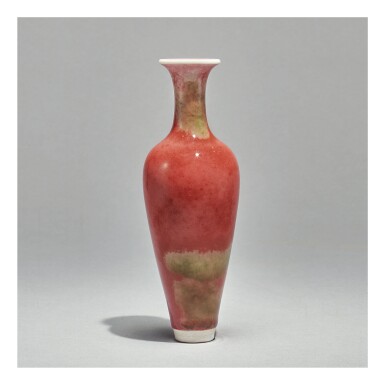
A FINE PEACHBLOOM-GLAZED AMPHORA VASE, KANGXI MARK AND PERIOD
Auction Closed
September 22, 02:00 PM GMT
Estimate
200,000 - 300,000 USD
Lot Details
Description
A FINE PEACHBLOOM-GLAZED AMPHORA VASE
KANGXI MARK AND PERIOD
清康熙 豇豆紅釉柳葉瓶 《大清康熙年製》款
the slender tapered body with rounded shoulders rising to a tall flared neck, covered overall in a vivid mottled strawberry-red glaze, the neck and base each with a swath of beige speckled with 'unripe peach' green, the glaze stopping above the foot to reveal the white body, the interior applied with a similar pinkish glaze shading to a mushroom tone, the lip and deeply recessed base glazed white, the base with a six-character mark in underglaze blue in two columns
Height 6⅛ in., 15.4 cm
Sotheby's Hong Kong, 20th May 1981, lot 785.
來源
香港蘇富比1981年5月20日,編號785
Exhibition of Ancient Chinese Ceramics from the Collection of the Kau Chi Society of Chinese Art, Art Gallery, The Chinese University of Hong Kong, Hong Kong, 1981, cat. no. 125.
Zhongguo mingtao riben xunhui zhan. Gangtai mingjia shoucang taoci jingpin [Exhibition of Famous Chinese Ceramics Touring Japan. Fine Ceramics from Private Hong Kong and Taiwanese Collections], Nihonbashi Takashimaya, Tokyo, 1992, p. 165.
展覽
《求知雅集珍藏•中國古陶瓷展》,香港中文大學文物館,香港,1981年,編號125
《中國名陶日本巡迴展•港台名家收藏陶瓷精品》,日本橋高島屋,東京,1992年,頁165
This attractive bottle with its tall tapering body, delicate foot and gently flared neck is an iconic product of the imperial kilns under the direction of the early Qing court. Its delicate form exudes a sense of understated elegance while its luscious glaze, with dark-red flecks combined with various hues of green, evokes a design formed in nature. Ralph M. Chait succinctly describes bottles of this type as defying description, ‘as the pen cannot convey any idea of its subtle rhythm of line, mass and balance’ (Ralph M. Chait, 'The Eight Prescribed Peachbloom Shapes bearing K’ang Hsi Marks', Oriental Art, vol. III, no. 4, Winter 1957, p. 139).
With its wide range of tones and variegated effects, the peachbloom glaze ranks among the most important innovations developed by the imperial kiln factory in Jingdezhen, Jiangxi province. Peachbloom is special among Qing dynasty glazes as it deliberately exploits the different decorative effects that the elusive copper pigment produced during firing. Copper pigment had been largely abandoned after the Xuande reign (r. 1426-35) because it was notoriously difficult to fire and often produced uneven and unsatisfactory results. To control the pigment’s tendency to run, copper-lime was sprayed onto the surface of the vessel through a bamboo tube that had a piece of gauze at one end, ‘sandwiched’ between two layers of clear glaze. This technique allowed for a wide range of natural effects, as seen in the dark-red flecks and large watery-green patch above the foot of this piece. While technically innovative, the serendipitous nature of this glaze is reminiscent of Song dynasty (960-1279) wares, which were admired for their subtle variations.
After a period of standstill that lasted nearly sixty years from the end of the Wanli period (1573-1620), the imperial kilns at Jingdezhen were revived and placed under the direct control of the court. The appointment of Zang Yingxuan as supervisor of the imperial kilns and his arrival at Jingdezhen on the 20th year of Kangxi’s reign, corresponding to 1681, initiated a new era of high-quality production. Imperial peachbloom wares were produced only in the Kangxi period and leading scholars including Peter Lam and Wang Qingzheng suggest they can be attributed to the period Zang was supervisor of the kilns, on the grounds of textual and stylistic evidence (Wang Qingzheng, ‘Jingdezhen Porcelain Wares of the Kangxi Era, Qing Dynasty’, Kangxi Porcelain Wares from the Shanghai Museum Collection, Hong Kong, 1998, pp XIX and XX; Peter Lam, ‘Qing Monochromes and Tang Ying’, A Millenium of Monochromes: From the Great Tang to the High Qing, The Baur and the Zhuyuetang Collection, The Baur Foundation, Geneva, 2018, p. 146). However, a copper-red ‘souffle’ glaze is mentioned in the 1712 letter written by the Jesuit missionary Père d’Entrecolles (1664-1741), suggesting that peachbloom wares may still have been produced at that time (Lu Minghua, ‘Qing Imperial Monochromes of the Kangxi, Yongzheng and Qianlong Reigns’, Qing Imperial Monochromes. The Zande Lou Collection, Shanghai Museum, Shanghai, 2005, pp 28 and 29).
The peachbloom glaze is found on a small number of vessels, which were first discussed by Ralph Chait in his influential essay op. cit., pp 130-137. Chait refers to this vase as Guanyin ping (Guanyin bottle), as the bodhisattva Guanyin is often depicted holding such a vase. Vases of this form are also known as liuye ping (willow-leaf bottles), in reference to one of Guanyin’s attributes, a branch of willow, or alluding to the resemblance of its form to a slender willow leaf. The form of this vase is particularly elegant and would have required a stand to be securely displayed as its narrow foot, recessed base and elongated form made it unstable. The potter cleverly designed the piece with a high foot which has been left unglazed to accommodate the stand.
Peachbloom vases of this form include a bottle in the Palace Museum, Beijing, published in Compendium of Collections in the Palace Museum. Ceramics, vol. 23, Shunzhi (1644-1661) and Kangxi (1662-1722) Periods of Qing Dynasty (II), Beijing, 2013, pl. 37; a vase in the Shanghai Museum, illustrated in Liu Liang-yu, A Survey of Chinese Ceramics, vol. 5, p. 56 (top right), together with one in the National Palace Museum, Taipei, p. 73 (right); and a further bottle in the Hong Kong Museum of Art, included in the Museum’s exhibition The Wonders of the Potter’s Palette, Hong Kong, 1984, cat. no. 29.
本瓶造型秀麗,瓶身修長,足部纖小,瓶頸微外撇,乃清初御窰經典。器型典雅含蓄,釉色明亮,斑紋深紅,與綠斑交織,渾然天成,不見匠氣。Ralph M. Chait 形容此類瓶「線條流暢度、器型比例及細微平衡,非筆墨所能形容」( Ralph M. Chait,〈The Eight Prescribed Peachbloom Shapes bearing K'ang Hsi Marks〉,《Oriental Art》,卷III,第4冊,1957年冬,頁139)。
豇豆紅釉色澤多樣,斑斕效果豐富,乃江西景德鎮御窰創新臻品。清代豇豆紅釉利用銅紅窰燒不穩之特質,創製各種效果,獨特新穎。單色紅釉因窰燒困難,成品質素不穩,自明宣德後幾近棄絕。為控制釉藥易於流淌之傾向,相信藝匠先以透明釉作底,以竹管吹釉,最後再次罩透明釉燒成,並憑此法燒成多種自然紋飾,例如本品近足處深紅斑紋及大片淡綠色斑。此技雖屬創新,燒成釉色與宋代名瓷同樣有賴天成,以變化含蓄見稱。
自明朝萬曆末期起,景德鎮官窰近六十載停產,後來由朝廷直接監管,康熙二十年,臧應選前往景德鎮任督陶官,乃另一製瓷盛世之始。豇豆紅釉器,僅製於康熙一朝,跟據林業強、汪慶正等學者研究相關文獻及瓷器風格,豇豆紅釉器相信乃製於臧應選督造期間(汪慶正,〈景德鎮康熙瓷〉,《上海博物館藏康熙瓷圖錄 》,香港,1998年;林業強,〈Qing Monochromes and Tang Ying〉,《A Millennium of Monochromes: From the Great Tang to the High Qing. The Baur and the Zhuyuetang Collections》,鮑氏基金會,日内瓦,2018年,頁146)。耶穌會傳教士昂特雷科萊(漢名殷弘緒)一封1712年信件提及一件「吹紅」器,顯示豇豆紅釉或於當時尚有燒製(陸明華,〈清康雍乾單色釉官窯瓷器研究〉,《暫得樓清代官窯單色釉瓷器》,上海博物館,上海,2005年,頁28及29)。
豇豆紅釉瓷非常珍罕,首先由 Ralph Chait 撰文提出,該文章影響力甚廣,見前述出處,頁130-137。由於觀音造像常刻劃觀音手持此類瓶,故 Chait 稱之為觀音瓶。此外,此瓶亦稱柳葉瓶,既因器型如修長柳葉,亦因觀音手持楊枝。此瓶器型秀麗,足部纖小,瓶底内收,瓶身修長,必須配上底座,方可穩置,而高瓶足光素無釉,乃為配合底座而設。
北京故宮博物院收藏一例,載於《故宮博物院藏品大系.陶瓷編》,卷23:清順治康熙,北京,2013年,圖版37;上海博物館收藏一瓶例,圖載於劉良佑,《中國歷代陶瓷鑑賞》,卷5:頁56(右上),同書並載台北國立故宮博物院收藏一例,頁73(右);另比一例,藏於香港藝術館,曾展於《清瓷薈錦—香港藝術館藏清代陶瓷》,香港,1984年,編號29。
